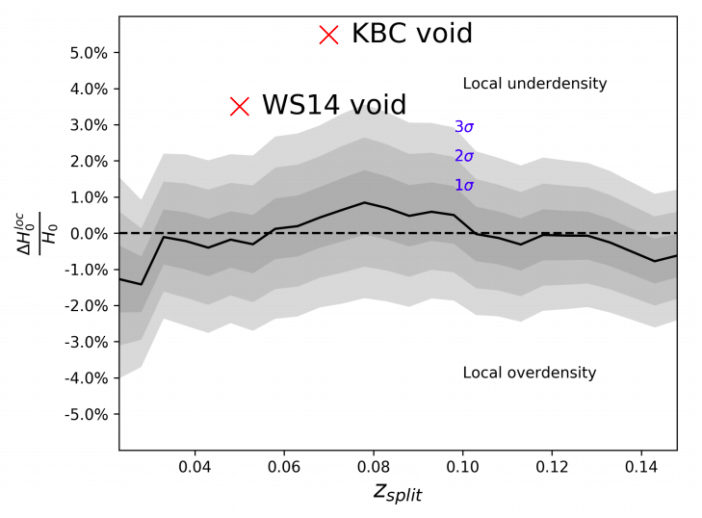Editor’s note: Astrobites is a graduate-student-run organization that digests astrophysical literature for undergraduate students. As part of the partnership between the AAS and astrobites, we occasionally repost astrobites content here at AAS Nova. We hope you enjoy this post from astrobites; the original can be viewed at astrobites.org.
Title: The Local Perspective on the Hubble Tension: Local Structure Does Not Impact Measurement of the Hubble Constant
Author: W. D’Arcy Kenworthy, Dan Scolnic, and Adam Riess
First Author’s Institution: Johns Hopkins University
Status: Submitted to ApJ
Why so Tense?
Feeling a bit tense these days? So is the value of the Hubble constant. This parameter, written as H0, governs the rate of expansion of the universe, caused by some unknown dark energy. Despite cosmologists’ best efforts at massaging out the knots, H0 has long suffered from a tension between competing measurements. Today’s paper uses more precise data to reevaluate one possible cause of this tension.
The Hubble constant is the proportionality factor between the distance of a galaxy and the speed with which it moves away from us; galaxies that are further away move away increasingly faster, as expected from the expansion of space. We measure H0 in units of km/s/Mpc, which I like to think of as the clogs of the unit world: clunky-looking but really quite sensible. It means that for every megaparsec (Mpc) further away you look, the galaxies there appear to speed away faster by H0 kilometers per second.
There are two main independent ways H0 has been measured: from the cosmic microwave background (CMB) and from the cosmic distance ladder. The former measurement was most recently made by the Planck satellite; for details, check out this astrobite. This gives a value of H0 = 67.4 ± 0.5 km/s/Mpc.

Figure 1: The cosmic distance ladder. We use stellar parallax, Cepheid variable stars and Type Ia supernovae (among others) as rungs along the ladder to measure distances to sources. [NASA/ESA]
A Void in the Distance Ladder
One place an issue could be hiding is in how we measure the distances to the galaxies, with what is known as the cosmic distance ladder, shown in Figure 1. The latest measurements are based on on Type Ia supernovae, which are fairly reliable standard candles. But to calibrate these distances, we need other more close-by candles, often Cepheid variable stars in local galaxies. You can guess where this is going: to calibrate the Cepheids, we have to keep stepping down the ladder. If any of these ladder rungs are “broken,” the more distant measurements will have a systematic offset.
Today’s paper considers what would happen if our distance measurements to nearby galaxies were off. This could be the case if the Milky Way were at the center of a local void (an under-density of galaxies), also known as a Hubble Bubble. This would cause the surrounding galaxies to be more strongly drawn towards higher-density regions, away from us. The extra pull would make the value for H0 that we measure locally higher than the true value; fixing this would bring it closer to the CMB measurement.
A Drop-Off in the Hubble Constant?
The authors use a sample of 1,295 supernovae covering a range of distances to probe the local structure with higher precision than has been done previously. They plot a modified Hubble diagram, known as a magnitude-redshift diagram (Figure 2), from which they calculate the value of H0.

Figure 2: A Hubble diagram of the supernovae in today’s paper. Rather than the classic plot of galaxy velocity as a function of distance, with the slope of the points giving the value of the Hubble constant, this uses magnitude as a proxy for distance, and the x-axis is related to the velocity. The Hubble constant can be calculated from the x-intercept. [Kenworthy et al. 2019]
Devoid of Voids
The results of this are shown in Figure 3. The authors find that the biggest change is at z = 0.023, but only to a significance of <2σ. This means that any inhomogeneities in the local density would have only a small effect on their measurement of the Hubble constant. All of the differences are much weaker than the offset needed to resolve the tension with CMB data, so voids clearly can’t explain the entire discrepancy.

Figure 3: The change in the value of the Hubble constant as a function of the redshift of a potential void edge. The red crosses are voids predicted in previous works. The small changes disfavor the idea that a local void at any redshift has a significant effect on the Hubble constant. [Kenworthy et al. 2019]
While the paper only investigates a simple, sharp-edged void model, it makes a strong case that local voids aren’t significant to the measurement of the Hubble constant. Future supernova observations will allow us to probe other systematics that may be just the masseuse we need to relieve the Hubble tension.
About the author, Kate Storey-Fisher:
Kate is a PhD student in the Center for Cosmology and Particle Physics at New York University. She studies the large-scale structure of the universe using cosmological simulations and galaxy surveys. She is still waiting for the galaxies to respond to the SurveyMonkey she beamed to them.


3 Comments
Pingback: AAS Nova – New
Pingback: “Energia Escura” (o Vácuo Contra-Ataca!…) | Questões Cosmológicas
Pingback: Place your bets: LCDM vs. El Gordo | astrobites